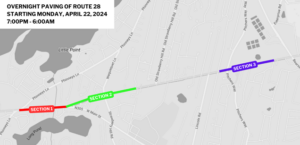
State Fire officials remind you to Replace Batteries in Smoke and CO Alarms, and Replace Alarms More Than 10 Years Old
STOW, MA – With the start of daylight savings time coming on March 13, Massachusetts fire officials issued a seasonal reminder to check your smoke and carbon monoxide (CO) alarms when you change your clocks.
“Working smoke and CO alarms are crucial home safety tools,” said State Fire Marshal Peter J. Ostroskey. “As we ‘spring forward’ this weekend, remember to check your alarms when you change your clocks. Unless you have newer alarms with 10-year sealed batteries, this is a good time to replace the alkaline batteries in your smoke and carbon monoxide alarms or replace the entire device if it’s more than 10 years old.”
Winter isn’t over yet, State Fire Marshal Ostroskey said, and carbon monoxide remains a hazard even in warmer weather.
“Carbon monoxide is the leading cause of poisoning deaths in the United States,” he said. “Many cases involve furnaces and other heating appliances, but CO is also produced by stoves, grills, and vehicles, as well as generators put into use during a power outage. We can’t see, smell, or taste carbon monoxide. Working CO alarms are the only way to detect this invisible killer.”
Replace Aging Smoke Alarms
“Just like any appliance, smoke alarms don’t last forever,” said Chief Michael Winn, president of the Fire Chiefs Association of Massachusetts. “An alarm’s manufacturing date is printed on the back of the device. Smoke alarms usually need to be replaced after 10 years, and carbon monoxide alarms after five to seven years. If the date on your alarm is more than 10 years ago, or if there’s no date at all, it’s time to replace the alarm.”
Replacement Alarms Should be Photoelectric With 10-Year Sealed Batteries
Replacing your old alarm? The State Fire Code requires replacement battery-operated smoke alarms in older one- and two-family homes to be photoelectric and have 10-year, sealed, non-replaceable, non-rechargeable batteries and a hush feature. Fire officials hope that if smoke alarms are easier to maintain, like those with long-life batteries, people will keep them in use rather than disabling them or forgetting to change out the batteries.
“Disabling a smoke alarm puts you and everyone in your home at risk,” said Chief Winn.
Create & Practice a Home Escape Plan
“In the average house fire, you could have less than three minutes to escape after the smoke alarm activates,” said State Fire Marshal Ostroskey. “Creating and practicing a home escape plan that includes two routes out will help you make the most of that precious time to get outside before poisonous gases and heat make escape impossible.”
“Working smoke alarms and a practiced home escape plan are among the most fundamental and important tools for surviving a fire,” said Chief Winn. “Be sure everyone in the home knows what to do and where to go when the alarm sounds, including young children, older adults, and persons with disabilities.”
Senior SAFE
Nearly half of last year’s fire deaths involved adults over the age of 65. More than 230 fire departments across Massachusetts have grant-funded Senior SAFE programs that may provide assistance with alarm installation and testing. Seniors who need help testing, maintaining, or replacing smoke alarms should contact their local fire department or senior center for assistance.
For more information on smoke alarms or the Senior SAFE program, visit www.mass.gov/dfs or contact your local fire department.























